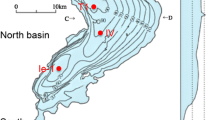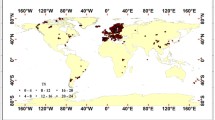Abstract
The objective of this study was to assess the current chemistry of trace elements in upland headwater lakes in Ireland and determine their trends during the last decade in response to decreasing emissions. Twenty-nine upland lakes were sampled in 2017–2018; 19 were previously sampled in 2007–2008. The 2017–2018 samples were analyzed for conductivity, pH, DOC, and 18 trace elements. The lakes had low element concentrations; only 7 of 18 trace elements were > 1 µg/L (Fe, Al, Zn, Mn, B, Sr and Ba). Nine elements were assessed for significant decadal changes; four elements decreased (B, Co, Mn, and Sr) and one increased (Pb). Their correlation with conductivity, pH, and DOC and the associated changes in those variables partially explained the observed trends. In general, elements that were correlated with DOC did not decrease, while those that were not correlated decreased between the two periods. Despite decreased anthropogenic emissions, ecosystem recovery and climate perturbations can confound or mask the benefits of emissions reductions.


Similar content being viewed by others
References
Aherne J, Kelly-Quinn M, Farrell EP (2002) A survey of lakes in the republic of Ireland: hydrochemical characteristics and acid sensitivity. Ambio 31(6):452–459
Asmala E, Carstensen J, Räike A (2019) Multiple anthropogenic drivers behind upward trends in organic carbon concentrations in boreal rivers. Environ Res Lett 14(12):124018
Bibi M, Wagreich M, Iqbal S (2020) Trace metals as markers for historical anthropogenic contamination: evidence from the Peshawar Basin, Pakistan. Sci Total Environ 703:134926
Burton A, Aherne J (2012) Changes in the chemistry of small Irish lakes. Ambio 41:170–179
Burton A, Aherne J, Hassan N (2013) Trace metals in upland headwater lakes in Ireland. Ambio 42(6):702–714
Driscoll CT, Driscoll KM, Fakhraei H, Civerolo K (2016) Long-term temporal trends and spatial patterns in the acid-base chemistry of lakes in the Adirondack region of New York in response to decreases in acidic deposition. Atmos Environ 146:5–14
EEA (2019) Air Quality in Europe – 2019 Report. European Protection Agency, Luxembourg. EEA Report No. 10/2019.
Evans CD, Monteith DT, Cooper DM (2005) Long-term increases in surface water dissolved organic carbon: observations, possible causes and environmental impacts. Environ Pollut 137(1):55–71
Garmo ØA, Skjelkvåle BL, de Wit HA, Colombo L, Curtis C, Fölster J, Hoffman A, Hruška J, Høgåsen T, Jeffries DS, Keller WB, Krám P, Majer V, Monteith DT, Paterson AM, Rogora M, Rzychon D, Steingruber S, Stoddard JL, Vuorenmaa J, Worsztynowicz A (2014) Trends in surface water chemistry in acidified areas in Europe and North America from 1990 to 2008. Water Air Soil Pollut 225(3):1880
Goddard SL, Williams KR, Robins C, Butterfield DM, Brown RJ (2019) Concentration trends of metals in ambient air in the UK: a review. Environ Monit Assess 191(11):683
Guerreiro CB, Foltescu V, De Leeuw F (2014) Air quality status and trends in Europe. Atmos Environ 98:376–384
Harmens H, Norris DA, Sharps K, Mills G, Alber R, Aleksiayenak Y, Blum O, Cucu-Man SM, Dam M, De Temmerman L, Ene A, Fernández JA, Martinez-Abaigar J, Frontasyeva M, Godzik B, Jeran Z, Lazo P, Leblond S, Liiv S, Magnússon SH, Maňkovská B, Karlsson GP, Piispanen J, Poikolainen J, Santamaria JM, Skudnik M, Spiric Z, Stafilov T, Steinnes E, Stihi C, Suchara I, Thöni L, Todoran R, Yurukova L, Zechmeister HG (2015) Heavy metal and nitrogen concentrations in mosses are declining across Europe whilst some “hotspots” remain in 2010. Environ Pollut 200:93–104
Huser B, Köhler S, Wilander A, Johansson K, Fölster J (2011) Temporal and spatial trends for trace metals in streams and rivers across Sweden (1996–2009). Biogeosciences 8(7):1813–1823
Lee K, Han C, Hong SB, Jun SJ, Han Y, Xiao C, Du Z, Hur S, Lee J, Boutron CF, Hong S (2019) A 300-year high-resolution Greenland ice record of large-scale atmospheric pollution by arsenic in the Northern Hemisphere. Environ Sci Technol 53(22):12999–13008
Lydersen E, Löfgren S, Arnesen RT (2002) Metals in Scandinavian surface waters: effects of acidification, liming, and potential reacidification. Crit Rev Environ Sci Technol 32(2–3):73–295
Mason R (2013) Trace metals in aquatic systems. Wiley-Blackwell, Hoboken. https://doi.org/10.1002/9781118274576.index
Met Éireann (2017) Climate of Ireland. Irish Meteorological Service (Met Éireann). www.met.ie/climate
Monteith DT, Stoddard JL, Evans CD, De Wit HA, Forsius M, Høgåsen T, Wilander A, Skjelkvåle BL, Jeffries DS, Vuorenmaa J, Keller B, Kopácek J, Vesely J (2007) Dissolved organic carbon trends resulting from changes in atmospheric deposition chemistry. Nature 450(7169):537–540
Oni SK, Futter MN, Bishop K, Kohler SJ, Ottosson-Lofvenius M, Laudon H (2013) Long-term patterns in dissolved organic carbon, major elements and trace metals in boreal headwater catchments: trends, mechanisms and heterogeneity. Biogeosciences 10(4):2315–2330
Pacyna JM, Pacyna EG (2001) An assessment of global and regional emissions of trace metals to the atmosphere from anthropogenic sources worldwide. Environ Rev 9(4):269–298
Perrin PM, Barron SJ, Roche JR, O’Hanrahan B (2014) Guidelines for a national survey and conservation assessment of upland vegetation and habitats in Ireland. Version 2.0. Irish Wildlife Manuals, No. 79. National Parks and Wildlife Service, Department of Arts, Heritage and the Gaeltacht: Dublin, Ireland
Sander S, Ginon L, Anderson B, Hunter KA (2008) Comparative study of organic Cd and Zn complexation in lake waters—seasonality, depth and pH dependence. Environ Chem 4(6):410–423
Shuhaimi-Othman M, Pascoe D, Borgmann U, Norwood WP (2006) Reduced metals concentrations of water, sediment and Hyalella azteca from lakes in the vicinity of the Sudbury metal smelters, Ontario, Canada. Environ Monit Assess 117(1–3):27–44
Tipping E, Rothwell JJ, Shotbolt L, Lawlor AJ (2010) Dynamic modelling of atmospherically-deposited Ni, Cu, Zn, Cd and Pb in Pennine catchments (northern England). Environ Pollut 158(5):1521–1529
UNECE (2012) 1998 Protocol on heavy metals. United Nations Economic Commission for Europe (UNECE). www.unece.org
UNEP (2019) Minamata convention on mercury: text and annexes. United Nations Environment Programme (UNEP). www.mercuryconvention.org
Veselý J, Hruška J, Norton SA (1998) Trends in water chemistry of acidified Bohemian lakes from 1984 to 1995: II. Trace elements and aluminum. Water Air Soil Pollut 108(3–4):425–443
WHO (2011) Adverse health effects of heavy metals in children. World Health Organisation (WHO). https://www.who.int/ceh/capacity/heavy_metals.pdf?ua=1
Worrall F, Burt T, Shedden R (2003) Long term records of riverine dissolved organic matter. Biogeochemistry 64(2):165–178
Acknowledgements
Financial support for this research was provided by the Irish Environmental Protection Agency under the Climate Change Research Programme (CCRP) 2014–2020 (Grant No. 2016-CCRP-MS.43).
Author information
Authors and Affiliations
Corresponding author
Additional information
Publisher's Note
Springer Nature remains neutral with regard to jurisdictional claims in published maps and institutional affiliations.
Electronic supplementary material
Below is the link to the electronic supplementary material.
Rights and permissions
About this article
Cite this article
Nelson, S.A.M., Aherne, J. Decadal Changes in Trace Metal Concentrations in Upland Headwater Lakes. Bull Environ Contam Toxicol 105, 679–684 (2020). https://doi.org/10.1007/s00128-020-02984-w
Received:
Accepted:
Published:
Issue Date:
DOI: https://doi.org/10.1007/s00128-020-02984-w




